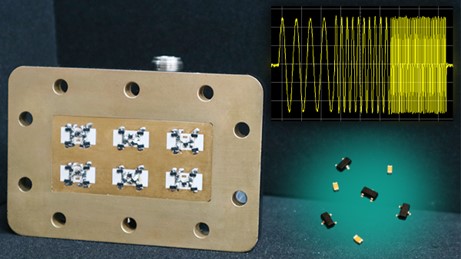RESEARCH NEWS - Addressing the Increase in Wireless Demand with Frequency-Hopping Metasurfaces
Category:News|Publishing : February 19, 2024
Recent advances in communication systems, such as the increase in mobile phone users, the adoption of Internet-of-Things devices, and the integration of smart sensors in applications ranging from smart homes to manufacturing have given rise to a surge in wireless traffic. Similar to how a roadway becomes congested with vehicles, the rising wireless traffic is resulting in congestion in the available frequency bands. New frequency bands have been introduced to accommodate more communication signals to operate wireless devices without severe interference with each other.
However, supporting a broad spectrum is challenging. There are only a limited number of frequency bands available. Additionally, it increases the complexity of wireless devices and infrastructure. One possible solution for accommodating signals within existing frequency bands is to tune them in a way to further distinguish them.
Now, in a new study published in Nature Communications, a team of researchers from Japan, led by Associate Professor Hiroki Wakatsuchi from Nagoya Institute of Technology, along with co-authors Ashif Aminulloh Fathnan and Associate Professor Shinya Sugiura of the University of Tokyo, has designed a metasurface that can distinguish wireless signals based on their frequency and pulse width.
In simpler words, metasurfaces are engineered surfaces that can manipulate incident electromagnetic waves to achieve specific modifications leading to the generation of different signals. This ensures that signals are separated and do not interfere with each other, reducing the likelihood of congestion-related issues. These materials can be integrated into radio-frequency devices like antennas and filters to accommodate more users and devices within the same frequency spectrum.
The metasurface developed by researchers in this study distinguishes signals more effectively than traditional materials. "Conventionally, when the number of frequencies available was N, electromagnetic waves and related phenomena could be controlled in N manners, which is now markedly extended to the factorial number of N (i.e., N!)," explains Dr. Wakatsuchi.
The developed metasurface consists of several unit cells that respond to specific frequencies. By activating multiple unit cells, it becomes capable of handling signals across multiple frequency bands. The metasurface can be thought of as a filter that selectively transmits signals based on specific frequency sequences. The researchers liken this to frequency-hopping, where devices switch frequencies rapidly to avoid interference. However, in this case, the metasurface can be tuned to alter incoming signals based on their frequencies. This property makes it possible to receive and distinguish a variety of signals of different frequencies from wireless devices.
As a result, with the new metasurface, the number of signals that can be distinguished grows from a linear relationship to a factorial-based one. "If four or five frequencies are available, the number of signals to be distinguished increases from four or five to 24 or 120," remarks Dr. Wakatsuchi, adding further, "Going ahead, this could help in more wireless communication signals and devices being made available even with limited frequency resources."
According to the researchers, the number of devices connected to wireless networks per square kilometer is projected to increase from a million in 5G to 10 million in 6G by 2030. This substantial increase will inevitably strain existing frequency bands. However, with their capability to distinguish wireless signals, metasurfaces represent a novel approach to operate numerous Internet-of-Things sensors and communication devices without severe interference.
In the long run, this will be important for next-generation communication services, such as autonomous driving, smart factories, digital twin, cyber-physical systems, and behavior recognition systems!

Novel Metasurfaces for Addressing the Increasing Demand of Wireless Technology
The metasurfaces respond to specific multiple frequencies, holding the potential to revolutionize next-generation communication networks.
Image Credit: Hiroki Wakatsuchi from Nagoya Institute of Technology
Usage Restrictions: Cannot be reused without permission
Reference
|
Title of original paper |
Frequency-Hopping Wave Engineering with Metasurfaces |
|
Journal |
Nature Communications |
|
DOI |
|
|
Publication Date |
January 3, 2024 |
About Associate Professor Hiroki Wakatsuchi
Dr. Hiroki Wakatsuchi is an Associate Professor in the Department of Engineering at Nagoya Institute of Technology (NITech), Japan. He completed his Ph.D. from The University of Nottingham, UK whereupon he did his postdoctoral research at UC San Diego, USA. His research interests include electromagnetics, electronics, and communications. He has so far published 62 papers (49 papers between 2005 and 2023) with over 800 citations to his credit. Dr. Wakatsuchi was also a part of the Precursory Research for Embryonic Science and Technology (PRESTO) in the Japan Science and Technology Agency (JST) until March 2023. Currently, he is involved with Fusion Oriented Research for Disruptive Science and Technology (FOREST), another JST program.
Funding information
This work was supported in part by the Japan Science and Technology Agency (JST) under Precursory Research for Embryonic Science and Technology (PRESTO) No. JPMJPR1933 and JPMJPR193A and under Fusion Oriented Research for Disruptive Science and Technology (FOREST), Japan Society for the Promotion of Science (JSPS) KAKENHI No. 17KK0114 and No. 21H01324 and the Japanese Ministry of Internal Affairs and Communications (MIC) under Strategic Information and Communications R&D Promotion Program (SCOPE) No. 192106007.
Contact
Associate Professor Hiroki Wakatsuchi
TEL : +81-52-735-5504
E-mail : wakatsuchi.hiroki[at]nitech.ac.jp
Links : Wakatsuchi Lab.
*Please replace [at] with @ when contacting .
Vice-Chancellor of Innovative Engineering Research Alliance of Universiti Teknologi Malaysia (UTM) visited our university. Professor HIRATA Akimasa assumes the position of chair of the International Commission on Non-Ionizing Radiation Protection (ICNIRP)-First chair from Asia since the establishment of ICNIRP

 Japanese
Japanese